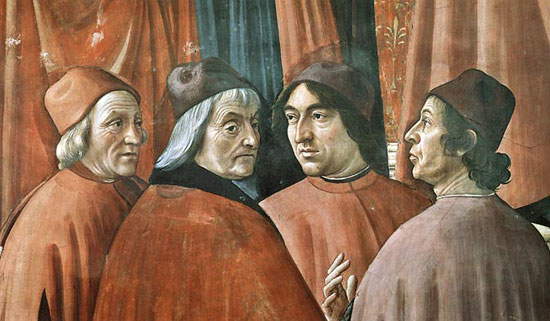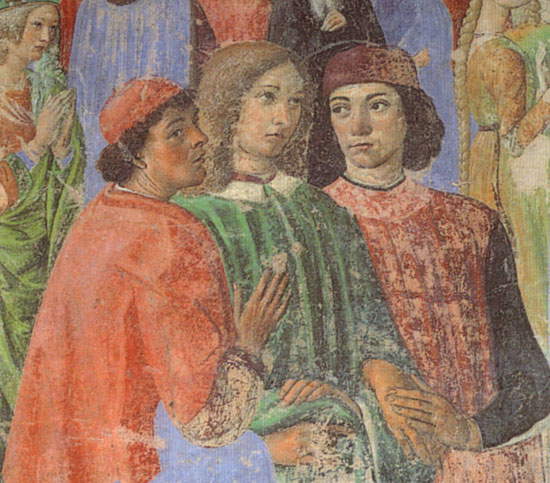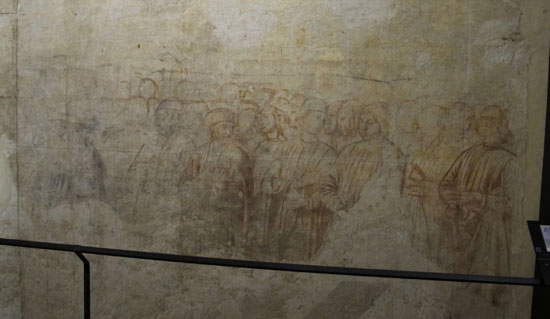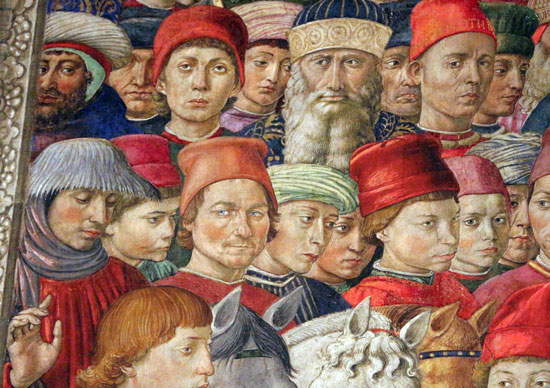He was also Cosimo’s lover and exalter of literate men; and therefore he brought to Florence Argilopolo, a man of the Greek nation and in those times most literate, so that from him the Florentine youth might learn the Greek language and its other doctrines. He nurtured in his houses Marsilio Ficino, the second father of Platonic philosophy, whom he supremely loved; and that he might more commodiously follow the studies of letters, and that he might be able to use it with more of his own commodity, a possession propinqua to his own at Careggi he gave him. These words, taken from the sixth book of Niccolò Machiavelli’s Istorie fiorentine, briefly illustrate one of the salient moments of the Florentine Renaissance: the birth of the Neoplatonic circle founded by the illustrious philosopher Marsilio Ficino (1433 - 1499), who from a very young age had to enter the good graces of the Medici. However, it is difficult to reconstruct the early studies and training of the great Tuscan humanist. Many have attempted to trace Marsilio Ficino’s interest in Plato’s philosophy rather far back, based on a letter in which the philosopher asserts that he began associating with Cosimo il Vecchio, the lord of Florence, as early as 1452. What is certain is that at least by 1456, relations between the philosopher and the lord were, so to speak, well established: in that year, Marsilio Ficino wrote the Institutiones ad platonicam disciplinam, his first work devoted to Platonic philosophy, which, we know, was read and appreciated by Cosimo.
The work was drafted on the basis of Plato’s texts that Marsilio Ficino had been able to read in Latin: for this reason, another great humanist active at the court of Cosimo the Elder, Cristoforo Landino (1424 - 1498), suggested that his younger colleague try his hand at the original Greek writings. Interest in Greek culture, already widespread in other Italian cities anyway, had begun to take root in fifteenth-century Florence, and Machiavelli also reminds us of this, following the arrival in the city of Giovanni Argiropulo (Ioannis Argyropoulos, 1416 - 1487), a Byzantine humanist who in 1456 was invited by Cosimo il Vecchio to Florence to teach Greek in the Florentine Studio (the name by which what is now the University of Florence to us was called at the time). Argiropulus, who had already been active in Italy for some time, promoted the spread of Greek culture in Florence as well: however, Marsilio Ficino was not his pupil, although the master who had come from the East enjoyed a very clear reputation. But this did not prevent Marsilio Ficino from feeling the fascination for Greek culture that had now spread to Florence as well, and which led him, in a short time, to become a fine connoisseur of the language and to begin an activity of translating Plato’s works.
It is a fact that Cosimo encouraged the studies (and translations) of Marsilio Ficino, giving him precious codices (in 1462 the philosopher received as a gift a manuscript containing all of Plato’s dialogues) and also a house: the one mentioned by Machiavelli, near the Medici villa in Careggi. This is 1463, and this donation would also sanction, according to historiographers who were supporters of Marsilio Ficino’s Platonic circle, the beginning of the meetings of the philosopher and his learned friends. About twenty-five years later, one of the best artists on the Florentine scene, Domenico Ghirlandaio, would pay homage to the leading humanists of his time by including their portraits in one of the frescoes in the Tornabuoni Chapel, the one with theAnnouncement of the Angel to Zachariah: we find them in the lower left group, the one attached to the lower edge of the composition. The first two figures, from the left, are the aforementioned Marsilio Ficino and Cristoforo Landino, at a visibly advanced age. The third is Angelo (or Agnolo) Poliziano (1454 - 1494), while the identity of the last one is uncertain: he could be Demetrius Calcondila (Demetrios Kalkokondyles, 1423 - 1511), a Greek humanist who moved to Florence in 1475, or Gentile de’ Becchi, a bishop from Urbino close to Lorenzo the Magnificent. The latter, just like his grandfather Cosimo, worked to protect the arts and culture, although some scholars have downplayed his role as a promoter of Platonic culture tout court: it seems that the Magnifico accorded equal support to all forms of thought.
 |
| Humanists in Domenico Ghirlandaio’s Tornabuoni Chapel: from left, Marsilio Ficino, Cristoforo Landino, Angelo Poliziano and Demetrio Calcondila or Gentile de’ Becchi (c. 1485-1490; Florence, Santa Maria Novella) |
Also part of the Ficinian cenacle was Giovanni Pico della Mirandola (1463 - 1494), who is splendidly portrayed by Cosimo Rosselli, together with Marsilio Ficino and Angelo Poliziano, in the Chapel of the Miracle in the church of Sant’Ambrogio in Florence, in the fresco depicting the Miracle of the Chalice: Pico is the blond one in the center, while Ficino and Poliziano are on the left and right respectively. The three humanists are portrayed in an unusual pose, that is, as they take each other by the arm. The gesture has been interpreted as a reference to the discipline of oratory according to Quintilian, who wrote in his Istitutiones, “Quippe non manus solum sed nutus etiam declarant nostram voluntatem” (“Not only hands, but also nods of the head declare our will”). Ficino, Landino, Poliziano, and Pico, although always associated by historiography with the same intellectual circle, had quite different interests and ideas. Leaving aside Poliziano, who was a poet and was mainly interested in poetry, it is possible to discern in the Neoplatonism of Ficino and Landino two different directions, especially analyzing their positions about the Active Life (the practice of virtues in order to make the earthly world better) and the Contemplative Life (the ecstasy that allows the human mind to unite with God), two key concepts of Neoplatonism. Both lives would allow man to achieve the temporal bliss that would enable him to rise above matter and the upheavals the latter would cause and prevent man from being a participant in the divine realm. Cristoforo Landino sought to accord equal dignity to the Active Life and the Contemplative Life (although he preponderated for the latter), while Marsilio Ficino believed that true and deeper bliss could only be attained through ecstasy: for this reason we can glimpse in Landino a more practical orientation, while in Ficino a more abstract one. Pico, for his part, was interested in reconciling the Platonic view of the world with the Aristotelian one (Poliziano himself, in the last years of his existence, studied Aristotle’s works in depth) and, in general, while starting from Ficino’s Neoplatonism, in giving life to an original (and, if you will, still relevant in its intentions) project of pax philosophica (“philosophical peace”) with the aim of bringing together different forms of thought and cultures.
 |
| Humanists in Cosimo Rosselli’s Chapel of the Miracle: from left, Marsilio Ficino, Giovanni Pico della Mirandola and Angelo Poliziano (c. 1486; Florence, Sant’Ambrogio) |
This circle of intellectuals would be renamed, by most historians, Accademia Platonica, based on several texts in which Ficino himself repeatedly adopts the term academia. It is, however, impossible to determine not only whether Marsilio Ficino and his friends identified themselves with the term academia, but it is also difficult to tell whether there was actually a circle of humanists who used to meet at Marsilio Ficino’s house in Careggi (or even at his neighbors, the Medici, in the villa in Careggi). It is true that in some writings, Marsilio Ficino refers to his villa with the high-sounding name Academia charegiana, “Academy of Careggi”: however, this would not prove that it was a place of habitual meetings among humanists. We have few certainties and many doubts: the U.S. historian James Hankins has shown how the term academia, in the writings of Ficino and his contemporaries, takes on different meanings depending on the contexts used, and that it is quite difficult to find passages in which the term can really identify a cenacle of intellectuals who gathered to discuss Platonic philosophy. Which would have led Hankis to believe that the Platonic Academy in Florence was nothing more than a myth invented by historiographers, and that Marsilio Ficino’s thought had spread mainly thanks to a kind of gymnasium, a school that boasted a conspicuous number of pupils and was informally linked to the Florentine Studio. According to Hankins, this school would have been the real academia: however, it is the scholar himself who points out that in this school not only Platonic philosophy was discussed, but also many other subjects. If it has therefore become anachronistic to think that aPlatonic academy existed in Florence (not least because many of the intellectuals considered close to this milieu were far from Platonic philosophy), and moreover patronized by the Medici, the debate about the form Marsilio Ficino’s sodality took (if it really existed) has not yet reached unanimous conclusions. Ficino himself offers evidence of at least two banquets, two Neo-Platonic"symposia" that were allegedly held in the fall of 1468, one of them at the Medici villa at Careggi, with Lorenzo the Magnificent present. The dinner is described as really happening and recounted by Ficino himself, in his 1474 De amore: the participants would have spent the evening discussing Plato’s theories on Love, and the Tuscan philosopher’s De amore would be nothing more than a kind of “account” of the comments that emerged from the dinner. Outside of these two accounts (although we do not know whether these are literary devices, or accounts of banquets that were actually held) we have nothing else to suggest dinners among intellectuals who gathered to discuss philosophy, letters, and the arts: the hypothesis nevertheless remains very fascinating.
However, it is certain that Ficino was one of the most important cultural figures in Medici Florence. Even leaving aside the conspicuous number of artists who were fascinated by his philosophical mission, which, according to Erwin Panofsky, pursued three very specific tasks (to make the writings of Plato and his followers accessible, to devise a philosophical system that would actualize Platonic thought, and finally to reconcile Platonism with the Christian religion), it would suffice to see how many were those who painted portraits of the philosopher to pay homage to him in far-reaching frescoes. Giorgio Vasari tells us that the painter Benozzo Gozzoli included the figure of Marsilio Ficino in one of the frescoes in the Camposanto in Pisa, which are, however, today scarcely legible because of the serious damage suffered over the centuries, especially during World War II: In the story therefore where the Queen Sheba goes to Solomon, Marsilio Ficino is portrayed among certain prelates, the Argiropolo, a learned Greek, and Batista Platina. The scholar Silvia Ronchey also recognizes a portrait of the philosopher (although this is a very doubtful hypothesis) in the frescoes of the Chapel of the Magi by Benozzo Gozzoli, in the Medici-Riccardi Palace in Florence: if it was indeed by Marsilio Ficino, it would probably be the oldest “homage,” since the chapel was frescoed when the humanist was just under 30 years old. We then mentioned above the representations of Ghirlandaio and Cosimo Rosselli, and this is only to limit ourselves to artists contemporary with Marsilio Ficino, but there were also several painters of later periods who included the figure of the Tuscan philosopher in frescoes celebrating Florentine glories. The hypothesis of the existence of a Platonic academy would, in short, still have to be proven with concrete evidence: however, the influence that Marsilio Ficino and his colleagues exerted on Florentine Renaissance culture remains undoubted.
 |
| The procession in the scene with Solomon and the Queen of Sheba by Benozzo Gozzoli (wall drawing; c. 1468-1484; Pisa, Museo delle Sinopie). Photo credit. |
 |
| Benozzo Gozzoli, possible portrait of Marsilio Ficino: second row, wearing red dress, blue-gray headdress and looking down (1459-1464; Florence, Chapel of the Magi) |
Reference bibliography
Warning: the translation into English of the original Italian article was created using automatic tools. We undertake to review all articles, but we do not guarantee the total absence of inaccuracies in the translation due to the program. You can find the original by clicking on the ITA button. If you find any mistake,please contact us.